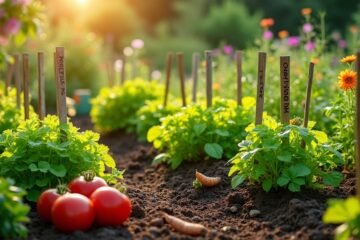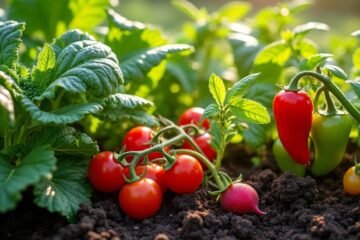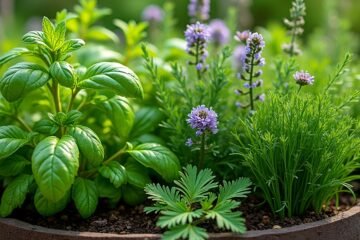Want to turn that tiny balcony into a bursting veggie paradise? Container gardening‘s your answer! Choose vibrant terracotta pots or trendy fabric bags; they not only look great but help drainage too. Think cherry tomatoes and baby greens that thrive in small spaces. Water them deeply and let the top soil dry out—it’s like giving plants a rejuvenating spa day! And hey, if you’re curious about more tips for your mini-garden, stay tuned for more juicy insights!
Choosing the Right Containers for Vegetables
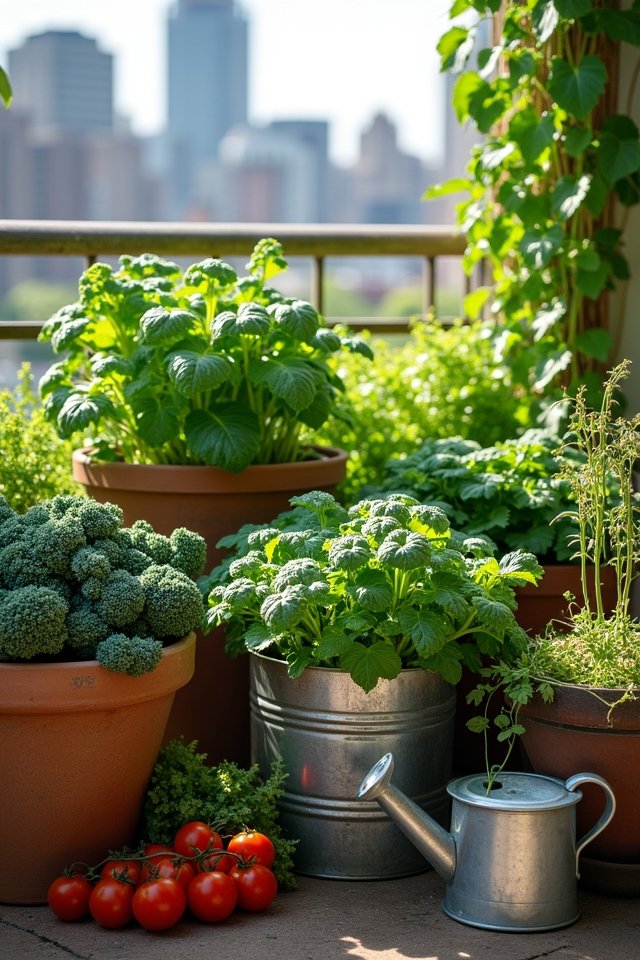
When it comes to choosing the right containers for your vegetable garden, the options are nearly endless—think of it like picking the perfect outfit for a fancy event! You’ve got container types ranging from classic terracotta pots to bold, modern fabric grow bags. How cool is that? Just imagine how your patio could pop with colorful containers!
Don’t forget about material considerations. Plastic is lightweight and easy to move, while wood adds a rustic charm and durability. Metal can bring a trendy edge, but make sure it’s insulated—nobody wants their roots to roast! So, when you’re ready to outfit your garden, remember to balance style, function, and drainage. Your veggies will thank you! Happy gardening!
Ideal Vegetables for Container Gardening
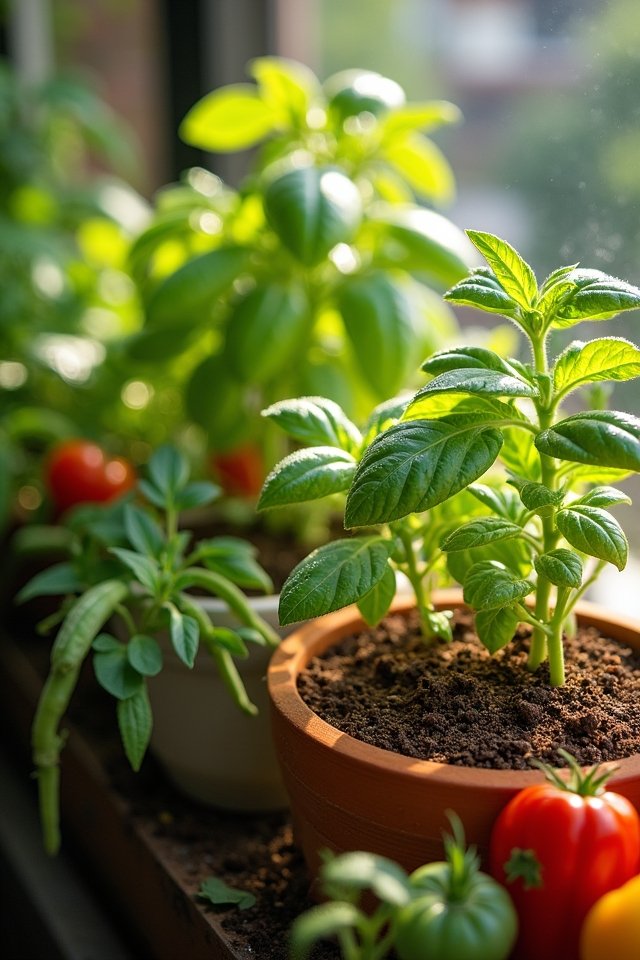
Ready to dig into container gardening? You’re in for a treat! For small spaces, compact crops are your best friends. Think cherry tomatoes, which are like little red gems, bursting with flavor. Baby greens? They’re the quicksilver of the gardening world—fast-growing and perfect for salads! Don’t forget herbs—basil and parsley thrive in pots, adding fresh scents to your kitchen.
When it comes to container size, larger pots hold more soil, nurturing bigger plants. A 5-gallon bucket works wonders for a single pepper plant, allowing it to thrive! Got a balcony? Try growing dwarf varieties; they’re as charming as they are practical. Surprise yourself with the bounty these small spaces can yield! Happy gardening—you’ve got this!
Soil and Fertilization Requirements
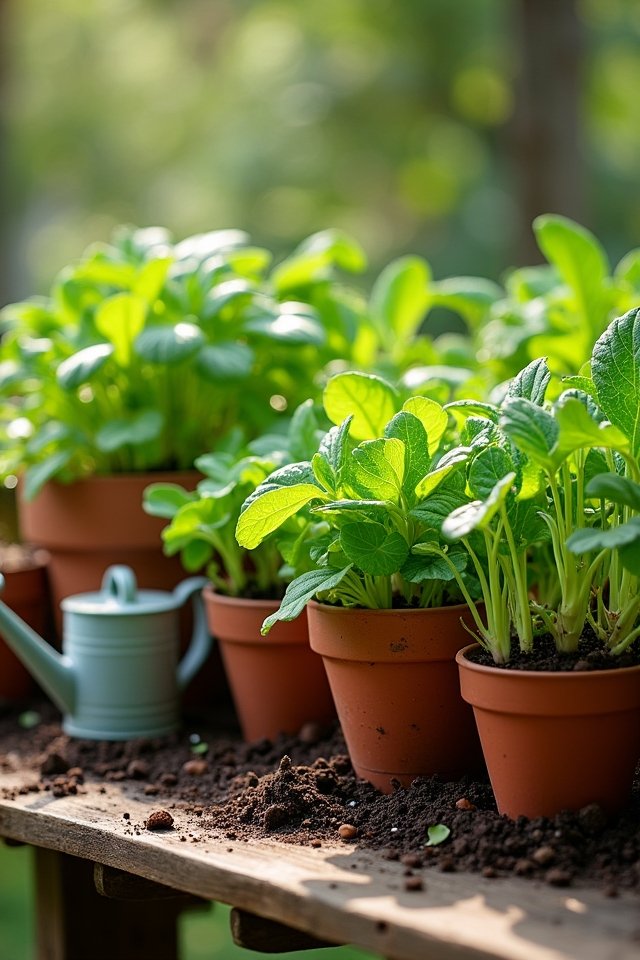
Choosing the right soil is like picking the perfect bed for your plants! You want them cozy, healthy, and ready to thrive. Opt for lightweight, well-draining soil types like potting mix that’s rich in organic matter—trust me, your veggies will thank you! As for fertilization schedules, think of them as your plants’ meal times. Start with a balanced organic fertilizer every 4-6 weeks; it’s like giving your veggies a nutritious snack! And don’t forget, each plant has unique nutrient needs—some may prefer a bit more nitrogen, while others crave potassium. So, mix it up and keep your leafy friends on their toes! When you nurture your soil and fertilize wisely, you’ll cultivate a bountiful harvest in your charming containers!
Light and Watering Needs
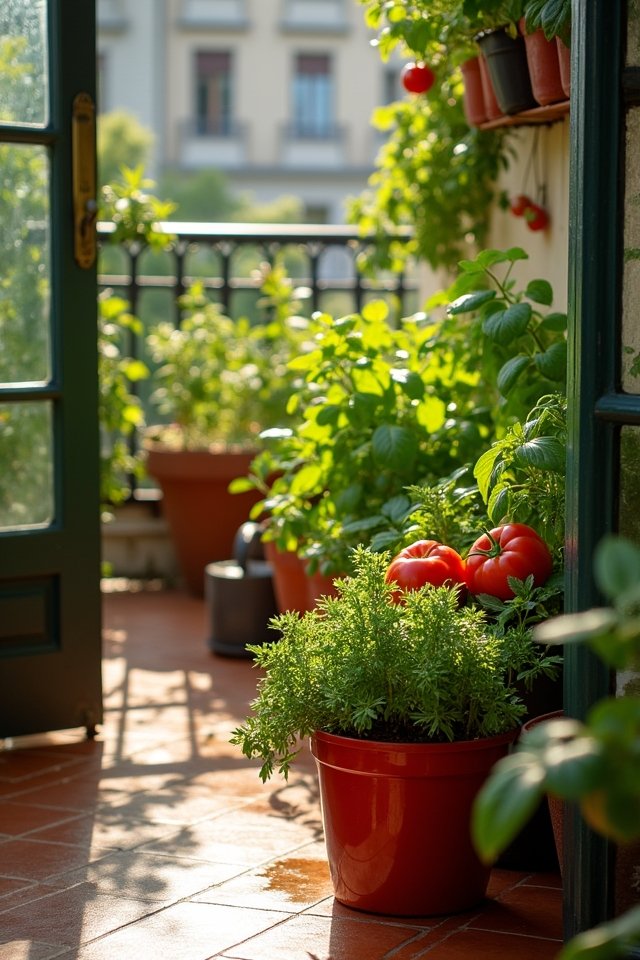
The success of your container vegetable garden hinges on giving your plants just the right amount of light and water! When it comes to sunlight exposure, think of your veggies as sunbathers. They thrive best with 6-8 hours of bright, direct sunlight daily—don’t let them get too cozy in the shade!
As for watering, you’ll want to keep a careful eye on moisture retention. Here are three essential tips:
- Check soil moisture regularly—stick your finger about an inch deep.
- Water deeply, but let the top layer dry out before the next drink.
- Use self-watering containers if you’re often busy—seriously, they’re life savers!
With the right light and water, your plants will flourish beautifully!
Vertical Gardening Techniques
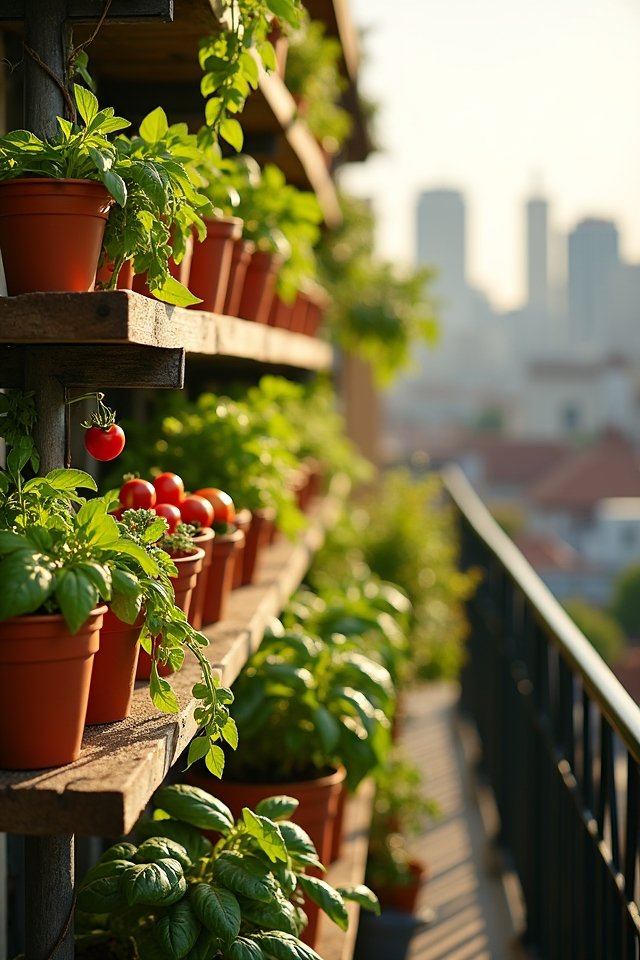
Vertical gardening techniques can transform even the smallest spaces into lush, green oases! Imagine your walls bursting with vibrant vegetables and fragrant herbs. Using trellis systems, you can let climbing plants, like cucumbers or peas, soar to new heights. They’ll create a stunning vertical display, almost like living art! Wall planters are another fantastic option. You can easily attach them to fences or walls, making them perfect for tight spots. Just envision rows of colorful peppers and cascading strawberries! It’s not only practical but also a conversation starter. Plus, vertical gardening can make your gardening game feel like a fun puzzle—every inch counts! So, why not elevate your gardening experience? Get ready for a vertical adventure!
Companion Planting in Containers
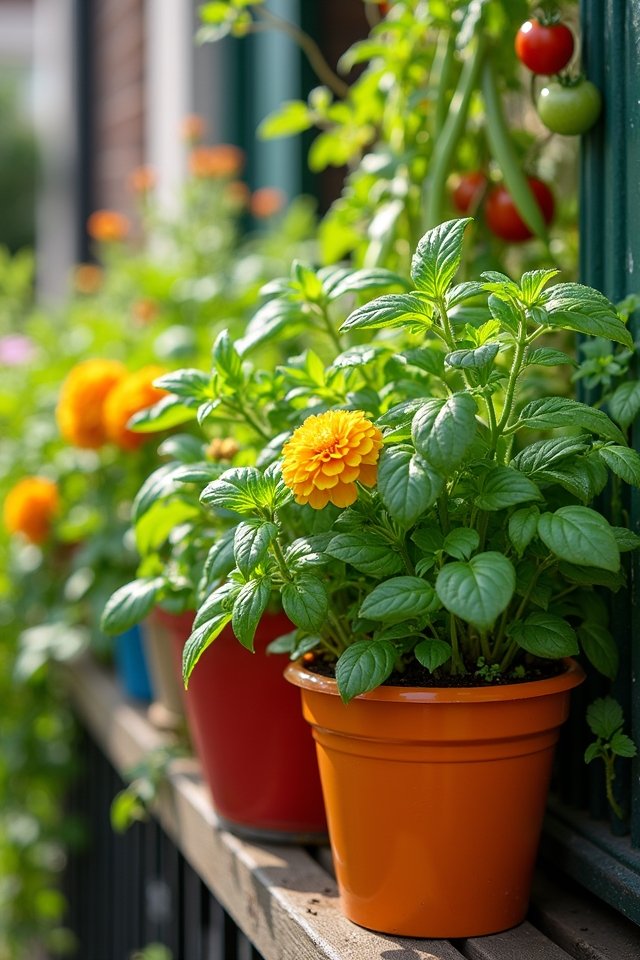
While you immerse yourself in the delightful world of container gardening, have you ever considered how companion planting can heighten your harvest? Imagine your container bursting with lush veggies and fragrant herbs!
To make the most of your limited space, try these simple herb pairings that thrive together:
- Basil and Tomatoes: Basil’s aroma repels pests while enhancing tomato flavor—talk about a match made in garden heaven!
- Mint and Carrots: Mint keeps pesky aphids away from your carrots, allowing them to flourish without competition.
- Chives and Peppers: Chives deter aphids, giving your peppers the breathing room they need for ideal spacing.
With these innovations, you’ll not only save space but boost your harvest, creating a mini-vegetable oasis!
Seasonal Considerations for Container Vegetables
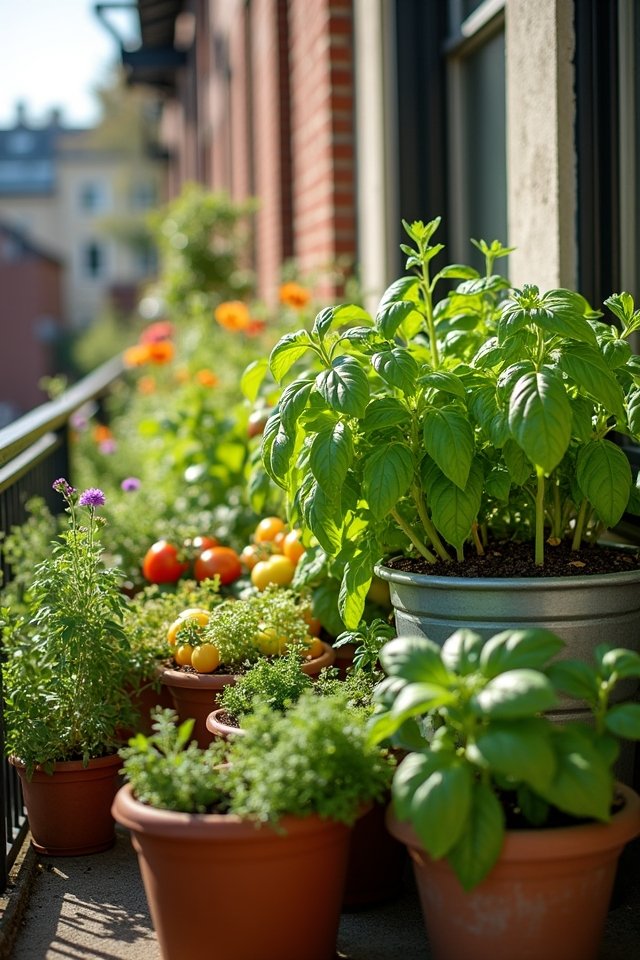
As you enjoy the art of companion planting in your containers, don’t forget to contemplate the seasons! Timing is everything in the world of container veggies! For example, starting your tomatoes indoors in early spring gives them a head start, while cool climate-loving lettuce thrives when planted in the fall. Welcome climate adaptability by choosing plants that suit your region’s temperature and weather patterns. Consider mixing herbs and veggies, like basil with peppers, to maximize flavors and utility! Isn’t it fascinating how your choices can transform a tiny space into a vibrant garden? Look for combinations that bloom in harmony! With some strategic planning, your containers will flourish, delivering joy and fresh produce throughout the year! Isn’t that rewarding?
Pest Management in Small Space Gardens
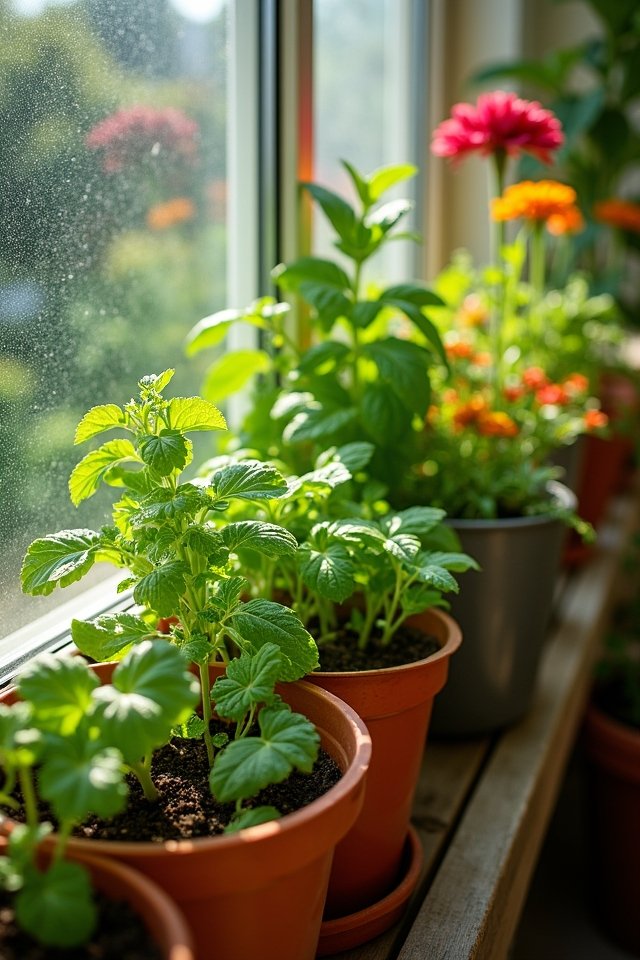
Ever wondered how to keep those pesky pests from raiding your precious container garden? You’re not alone! Luckily, managing pests in small spaces can be both fun and effective. Here are three organic solutions that can save your crops:
- Invite natural predators like ladybugs and lacewings. They’ll feast on aphids and other troublemakers!
- Use companion planting—pairing certain plants can deter pests. For example, basil near tomatoes keeps those pesky flies away!
- Create homemade sprays with ingredients like garlic or chili powder to send those invaders packing!
These innovative methods will not only protect your greens but also keep your garden eco-friendly. So roll up your sleeves, jump in, and watch those pests flee in horror! Happy gardening!
Frequently Asked Questions
Can I Grow Vegetables Indoors Using Containers?
You bet you can grow vegetables indoors using containers! Indoor gardening isn’t just practical; it’s like bringing a little patch of the outdoors inside. When you choose your containers, think about size and drainage—every plant needs its cozy home! Imagine snacking on fresh basil while the aroma fills your kitchen. With some sunlight and love, your tiny herb garden can flourish. So, why not give it a try? Happy gardening! 🌱
How Much Space Do Vegetable Containers Need?
How much space do vegetable containers need? It depends! For compact plants like radishes or herbs, smaller containers work—around 5 to 10 inches deep. But if you’re dreaming of luscious tomatoes or vibrant peppers, go bigger, at least 12 to 18 inches deep! Remember, larger vegetable varieties need more space to thrive, just like you when you’re stretching out on a cozy couch! So choose wisely, and let your garden flourish!
What Are the Signs of Overwatering in Containers?
You know your plants are in trouble when you notice yellow leaves drooping like sad little flags. If the roots are sitting in soggy soil, it could lead to root rot—a fate worse than a bad hair day! Overwatering can also cause the soil to smell musty. Check your containers! If they don’t drain well, it’s time to rethink your watering routine. Remember, a happy plant thrives on balance, just like life!
How Long Do Container Vegetables Usually Take to Grow?
Growing container vegetables is like watching a thrilling movie unfold! You’ll find that growth timelines vary depending on vegetable varieties. For instance, radishes can ready themselves in just 25 days, while luscious tomatoes might need up to 90 days. It’s a delightful surprise! So, as you nurture your plants with care, you’ll experience the joy of seeing them transform and thrive. Just remember, patience is key and tasty rewards are just around the corner!
Can I Reuse Potting Soil for Container Gardening?
Absolutely, you can reuse potting soil! Just think of it as recycling your garden’s treasure! However, it’s essential to refresh the soil nutrients. Mix in fresh compost or slow-release fertilizers to boost its power! Inspect for pests or mold—nobody wants those little guys crashing the party. If it smells like a wet sock, toss it! So, treat your potting soil right, and it’ll keep giving you green goodness! Happy gardening!
